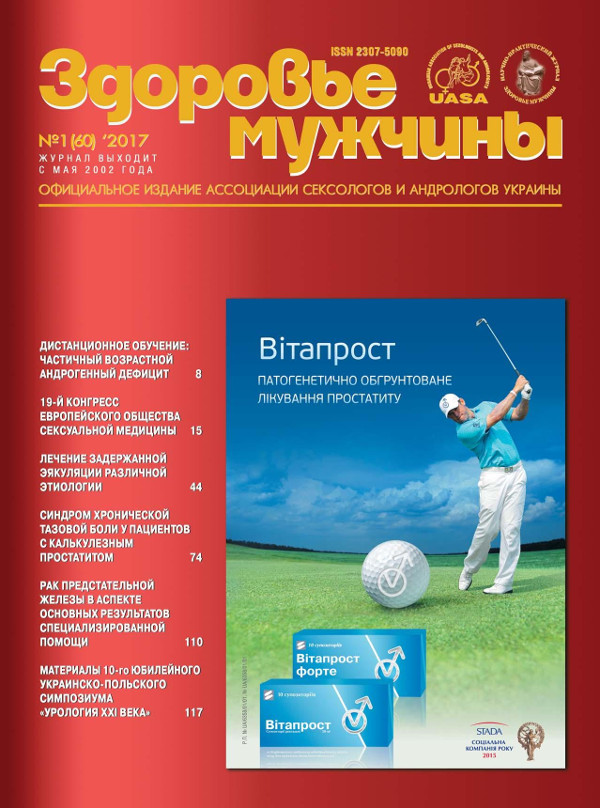Complications of miniinvasive radical prostatectomy in patients with localized prostate cancer
##plugins.themes.bootstrap3.article.main##
Abstract
The objective: the purpose is to analyze the complications of minimally invasive radical prostatectomy (MRPE) in patients with localized prostate cancer by determining the frequency and severity of postoperative complications.
Patients and methods. There are the results of the MRPE studied in patients with localized prostate cancer (n=157), which is made in SI «Urology Institute of National Academy of Medical Sciences of Ukraine» in 2013–2015. There were analyzed retrospectively and classified the type, the number and severity of complications.
Results. There are found 130 complications in 81 (51,6%) patients. Complications were classified according to a standard scale P.A. Clavien et al. (2009). One patient could have more than one complication. Mostly there were met genitourinary complications – 99 (63,1%), bleeding requiring hemotransfusion – 19 (12,1%) and infectious complications – 5 (3,2%). «Small» complications were met mostly (Clavien I–II) – 103 (79,2%), and 5 (3,8%) patients has hadcomplications 1st degree, 98 (75,4%) – of the 2nd degree. «Great» complications (Clavien III–IV) we observed in 27 (20,8%) patients, 23 (17,7%) of whom have arosed complications of 3rd degree, 4th degree complications have been observed in 4 cases (3,1%). Duration of urethral bladder drainage of patients with complications was up than in patients without complications regardless of MRPE, for 32,9% in the extraperitoneal endovideosсopic radical prostatectomy (EERP) and for 39,5% in laparoscopic radical prostatectomy (LRP). Percentage absence of prostate cancer in final histology examination was 3,8%.
Conclusions. The number and nature of the identified difficulties indicates the need for improved surgical technique MRPE, especially at the stage of vesico-urethral anastamosis.
##plugins.themes.bootstrap3.article.details##

This work is licensed under a Creative Commons Attribution 4.0 International License.
Authors retain the copyright and grant the journal the first publication of original scientific articles under the Creative Commons Attribution 4.0 International License, which allows others to distribute work with acknowledgment of authorship and first publication in this journal.
References
Siegel R., Naishadham D., Jemal A. Cancer statistics, 2013 //CA: a cancer journal for clinicians. – 2013. – Vol. 63. – No 1. – P. 11–30.
Center M., Jemal A., Lortet-Tieulent J. et al. International variation in prostate cancer incidence and mortality rates // Eur Urol. – 2012. – Vol. 61. – No 6. – P. 1079–1092.
Бюлетень національного канцер-реєстру України No 17 // Рак в Україні, 2014–2015. – К., 2015. – С. 54–55.
Mottet N., Bastian P., Bellmunt J. et al. Guidelines on prostate cancer //Eur Urol. – 2014. – Vol. 65, No 1. – P. 124–37.
Clavien P.A., Barkun J., de Oliveira M. et al. The Clavien-Dindo classification of
surgical complications: five-year experience // Annals of surgery. – 2009. – Vol. 250, No 2. – P. 187–196.
Boorjian R., Karnes R., Raugel L. et al. Majo Clinic validation of the D’Amico risk group classification for predicting survival following radical prostatectomy //J. Urol. – 2008. – Vol. 179, No 4. – P. 1354–1361.
Pierorazio P.M., Walsh P.C., Partin A.W. et al. Prognostic Gleason grade grouping: data based on the modified Gleason scoring system // BJU international. – 2013. – Vol. 111, No 5. – P. 753–760.
Borregales L.D., Berg W.T., Tal O. et al. ‘Trifecta’ after radical prostatectomy: is there a standard definition? //BJU international. – 2013. – Vol. 112. – No 1. – P. 60–67.
Leiblich A., Sooriakumaran P., Wiklund P. The Robotic Laparoscopic Radical Prostatectomy //Management of Prostate Cancer. – Springer International Publishing, 2017. – P. 181–186.





